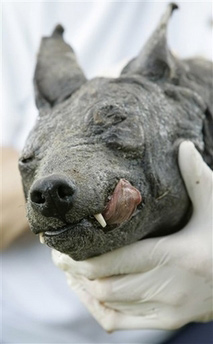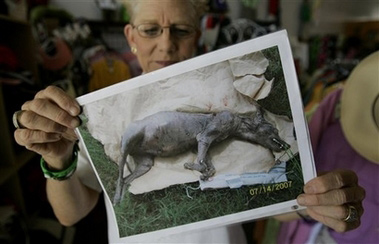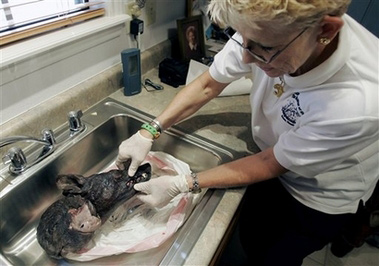Photos of alleged blood-sucking chupacabra found in Texas
mongabay.com
September 1, 2007
[update: probably a xolo dog]
Legendary blood-sucking beast found in Texas? Or is it just a dog gone wild?
Phylis Canion, a woman in Texas, believes she may have found the mythical blood-sucking chupacabra as roadkill near her ranch, reports the Associated Press.
The animal, described by Canion as “a cross between two or three different things”, was discovered last month. The beast resembles a dog but is mostly hairless with big ears and large fanged teeth.
“It is one ugly creature,” Canion told the Associated Press, “I’ve seen a lot of nasty stuff. I’ve never seen anything like this.”
Canion believes the animal is the chupacabra, a cryptid beast known in rural folklore in Puerto Rico, Mexico, and the United States. Its name translates to “goat sucker” from its alleged penchant of drinking the blood of livestock like a vampire. The Chupacabra is sometimes blamed for the disappearance and loss of goats, chickens and other farm animals.

Frozen head of a so-called Chupacabra in Cuero, Texas. (AP Photo/Eric Gay) |
Canion says she has lost up to 26 chickens in recent years, possibly as the result of the chupacabra.
After finding the roadkill, she put the beast’s head in her freezer for later DNA testing.
At least one local veterinarian is skeptical that the beast in Canion’s freezer is the so-called chupacabra.
“I’m not going to tell you that’s not a chupacabra. I just think in my opinion a chupacabra is a dog,” Travis Schaar of the Main Street Animal Hospital in nearby Victoria, who has seen Canion’s find, was quoted as saying. He believes it may just be an unusual breed of dog that prefers to let its prey blood out before feeding.
Nevertheless the sighting has spurred brisk sales in chupacabra apparel in the small Texas town of Cuero.
“If everyone has a fun time with it, we’ll keep doing it,” she told the AP. “It’s good for Cuero.”
Not the first chupacabra frenzy

|
Canion’s find is not the first time the carcass of a strange animal has stirred up a chupacabra frenzy. According to Wikipedia, in July 2004, a rancher near San Antonio killed a hairless dog-like creature, which was attacking his livestock. This creature was later determined to be a malformed coyote. Similarly in 2006 an apparent feral dog was killed in Maine. At the time it was reputed to be a “killer mutant beast.”
The legend of the chupacabra dates back to 1987 when Puerto Rican newspapers El Vocero and El Nuevo Dia reported on mysterious deaths of animals. Puerto Rican comedian Silverio Pérez is credited with coining the term “chupacabra.”
|
Species Identified: Xoloitzcuintle breed of dog more Regarding the “chupacabra” story: I believe I can What may be most disturbing is that three of these Finally, Phylis Canion may claim she knows exotic For dog lovers like me, [the story is] truly vile. Thanks for your time. Best regards, Claire |
Related articles
Chupacabra story is a hoax; likely a Xolo dog breed
(9/4/2007) An alleged chupacabra carcass found in Texas is likely a hoax to sell T-shirts say dog experts. The animal, described in an Associated Press report last week as “a cross between two or three different things”, was found as road kill last month near the Texas town of Cuero. The woman who discovered the carcass has been using it to market chupacabra T-shirts. In lively Internet discussions dog breeders say the carcass appears to be that of a Xoloitzcuintle or Xolo, otherwise known as a Mexican Hairless dog, rather than the blood-sucking creature of legend.
Vampires kill 23 in Brazil, deforestation blamed
(11/6/2005) Rabid vampire bats killed 23 people and attacked more than 1,000 Brazilian officials confirmed last week. The bats have been displaced from their normal rain forest environment by worsening deforestation in the region. In an attempt to slow deaths, health agencies have treated 1,350 people with anti-rabies medication in the past two months.
Scientists to investigate Bigfoot sighting in India
(6/10/2007) Indian authorities will conduct a “scientific study” to examine claims by villagers of Indo-Asian News Service. Villagers in the jungles of the Indian northeastern state of Meghalaya claim to have evidence of Bigfoot or Sasquatch, reports the Indo-Asian News Service. Government authorities said they will conduct a “scientific study” to examine the purported sightings near the border with Bangladesh.
New fox species discovered in jungle of Borneo
(5/24/2006) Scientists may have discovered a new species of fox-like mammal in the rainforests of Borneo. The animal was caught on film by an automatic infra-red camera positioned in the forest of the Kayam Menterong National Park in the Indonesian section of the island during a survey by the World Wildlife Fund (WWF).

|
Saving Orangutans in Borneo
(5/10/2005) The air is warm and heavy with the morning humidity typical of the Borneo rain forest as our kelotok, a traditional boat, motors up a river so black in color it could be mistaken for ink. The raucous calls of a pair of hornbills can be heard over the rumble of the engine as they fly overhead with their gaudy and over-sized beak adornments.
BBC airs purported footage of Loch Ness monster
(5/31/2007) BBC Scotland has aired video footage of what a man claims to be ‘Nessie’, the mysterious creature rumored to dwell in the deep Scottish lake. While scientists have thoroughly rejected the idea that Nessie is a dinosaur surviving from prehistoric times, they allow that the Loch Ness could house unknown species of fish or eels that could be mistaken for the beast of legend.
European blood-sucker falls victim to global warming
|
|
(08/27/2007) Europe’s only known land leech may be on the brink of extinction due to shifts in climate, report researchers writing in the journal Naturwissenschaften. The findings are significant because they suggest that “human-induced climate change without apparent habitat destruction can lead to the extinction of populations of cold-adapted species that have a low colonization ability,” according to the authors.
Rare Chinese river dolphin sighting in question

|
(08/31/2007) A prominent researcher is skeptical of last week’s reported sighting of the baiji, the Chinese river dolphin declared extinct earlier this year, according to the New York Times. The sighting near Tongling city in Anhui Province — widely reported in Chinese and Western media — was captured on video. Dr. Robert L. Pitman of the National Oceanic and Atmospheric Administration’s Fisheries Ecosystem Studies Program said Chinese scientists question that the video shows a baiji at all.
Killer ‘Hybrid Mutant’ creature found dead in Maine
(8/16/2006) The Associated Press is reporting the discovery of a strange ‘Hybrid Mutant’ creature in Maine. The animal, described as a 40 and 50 pound animal with “a bushy tail, a short snout, short ears and curled fangs hanging over its lips,” was apparently hit by a car as it chased a cat across a rural road in Androscoggin County. The creature had been blamed for a series of attacks on dogs and was the subject of local legend.
